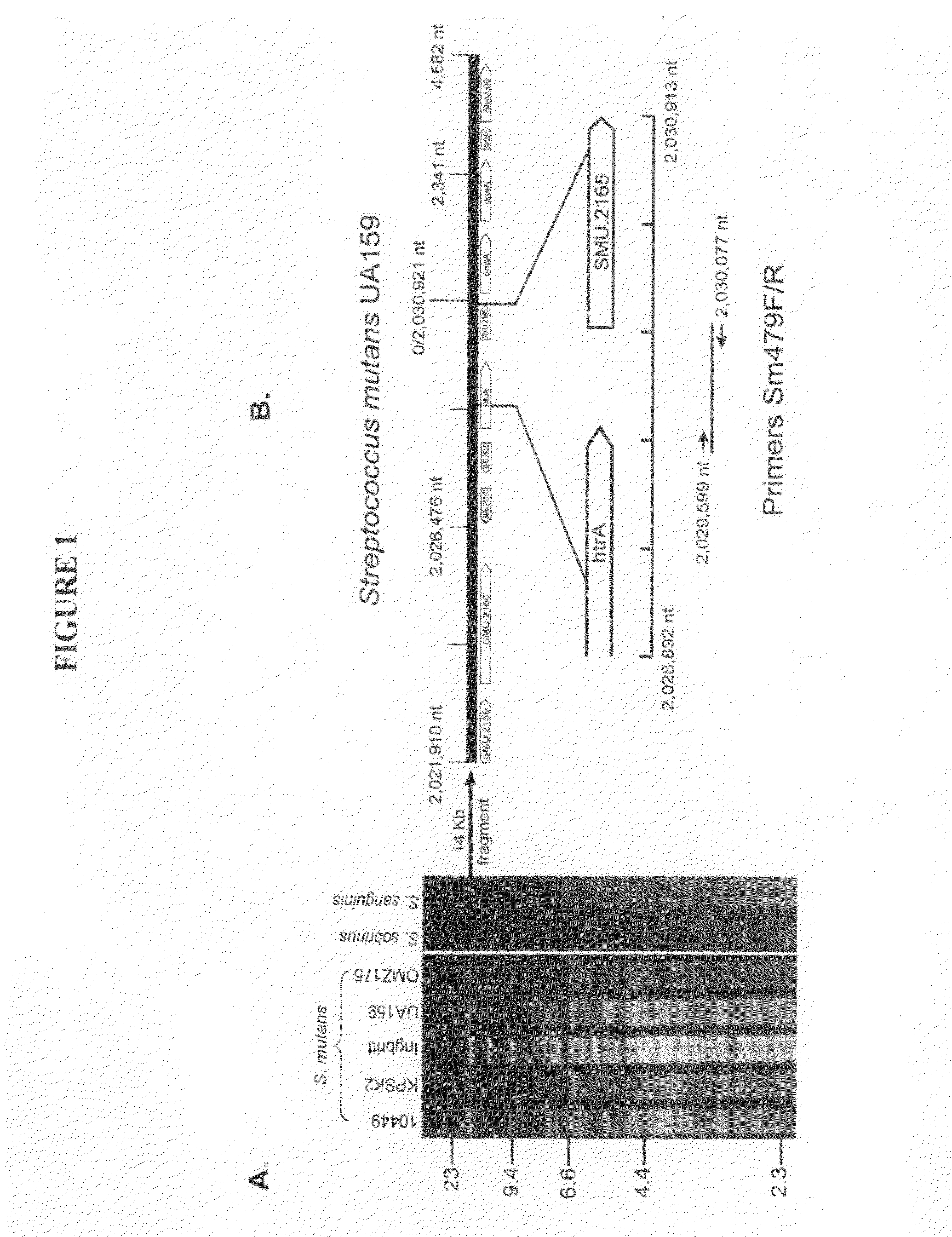Methods and species-specific primers for detection and quantification of Streptococcus mutans and Streptococcus sanguinis in mixed bacterial samples
a technology of streptococcus sanguinis and mixed bacterial samples, which is applied in the field of oral bacteria species assessment, can solve the problems of limited detection threshold of i>s. mutans /, high caries risk, and high cost and labor intensity, and achieve accurate and rapid identification and quantification of s, and the effect of reducing the risk of dental caries
- Summary
- Abstract
- Description
- Claims
- Application Information
AI Technical Summary
Benefits of technology
Problems solved by technology
Method used
Image
Examples
example 1
[0120]Streptococcus mutans is the major microbial pathogen associated with dental caries in children. The objectives of this study were to design and evaluate species-specific primers for the identification of S. mutans. Validation of the best primer set, Sm479F / R, was performed using 7 S. mutans reference strains, 48 ATCC non-S. mutans strains, 92 S. mutans clinical isolates, mixed DNA samples of S. mutans-S. sobrinus or S. mutans-S. sanguinis, and total cultivable bacterial DNA of saliva samples from 33 18-month-old children. All of the S. mutans samples tested positive, and no PCR products were amplified from members of the other streptococci or non-streptococci strains examined. The lowest detection level for PCR was 10−2 ng of S. mutans DNA (c. 4.6×103 copies) in the test samples. The results of our study suggest that the Sm479F / R primer pair is highly specific and sensitive for identification of S. mutans in either purified or mixed DNA samples.
Introduction
[0121]Dental caries ...
example 2
Duplex Real-Time QPCR Analysis of S. Mutans and S. Sanguinis Colonizations in Clinical Samples
[0185]Streptococcus mutans is the major microbial pathogens associated with dental caries. Streptococcus sanguinis (formerly S. sanguis), is also a key member of the indigenous oral biota colonizing dental plaque. S. sanguinis is one of the most prevalent members of the oral streptococci, especially on tooth surfaces with no caries present. S. sanguinis may serve a protective or antagonistic role against the cariogenic bacterium S. mutans (Caufield, P. W. et al. (2000) Infect. Immun. 68:4018-4023; Loesche, W. J. and Syed, S. A. (1973) Caries Res. 7:201-216; Loesche, W. J. et al (1973) Arch. Oral Biol. 18:571-575). Based on conventional culture methods, it has been suggested that S. mutansis / S. sanguinis ratio may serve as a caries risk indicator. S. sanguinis may also cause or be associated with bacterial endocarditis and septicemia (Douglas, C. W. et al. (1993) J. Med. Microbiol. 39:179-18...
example 3
Real-Time (PCR Assay for Detection and Enumeration of S. mutans and S. Sanguinis in Children
[0197]Previously and above in Example 1 we reported two sets of primers, Sm479F / Sm479R and Sa475F / Sa475R can be used to detect S. mutans and S. sanguinis by conventional PCR in clinical samples. The purpose of this study is to perform real-time quantitative PCR by applying these S. mutans-specific or S. sanguinis-specific primers in saliva samples of very young children. A total of 584 bacterial genomic DNA samples from 109 children aged from birth to 36 months old were included in this study. Real-time quantitative PCR amplification, data acquisition, and analysis were carried out using the DNA Engine Opticon 2 System (MJ research Inc., Alameda, Calif.). S. mutans UA159 and S. sanguinis ATCC10556 genomic DNA samples were used as the references strain and for the establishment of standard curves for testing clinical samples. Findings of this study show an overall concordance between the PCR a...
PUM
| Property | Measurement | Unit |
|---|---|---|
| Fluorescence | aaaaa | aaaaa |
Abstract
Description
Claims
Application Information
 Login to View More
Login to View More - R&D
- Intellectual Property
- Life Sciences
- Materials
- Tech Scout
- Unparalleled Data Quality
- Higher Quality Content
- 60% Fewer Hallucinations
Browse by: Latest US Patents, China's latest patents, Technical Efficacy Thesaurus, Application Domain, Technology Topic, Popular Technical Reports.
© 2025 PatSnap. All rights reserved.Legal|Privacy policy|Modern Slavery Act Transparency Statement|Sitemap|About US| Contact US: help@patsnap.com



